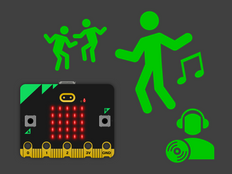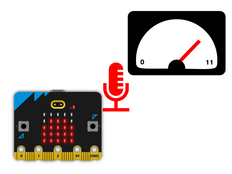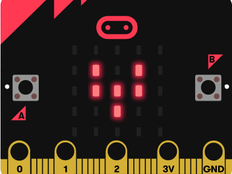Étape 1 : Fais-le
Qu'est-ce que c'est ?
Faites en sorte que le microphone du nouveau micro:bit réponde quand on frappe dans les mains et bat avec une animation lumineuse.
Introduction
Guide de codage
Ce que vous apprendrez
- Comment les ordinateurs reçoivent des entrées, les traitent en utilisant du code et créent des sorties différentes
- Comment utiliser le capteur microphone intégré du nouveau micro:bit pour déclencher des événements dans votre code
- Que le microphone du micro:bit puisse être utilisé pour répondre aux sons à la fois silencieux et bruyants
Comment ça marche
- Lorsque le microphone détecte un son fort, comme quand vous frappez dans vos mains, il affiche un grand cœur sur l'écran LED.
- S'il détecte un son silencieux, par exemple une fois que vous avez fini de taper dans vos mains, un petit cœur s'affiche.
- L'effet permet de créer une animation cardiaque simple qui répond à des claps ou des rythmes forts dans la musique.
Ce dont vous aurez besoin
- nouveau micro:bit avec son (ou simulateur MakeCode)
- MakeCode ou éditeur Python
- un coupleur de piles (optionnel)
Étape 2 : Programme-le
Étape 3 : Améliore-le
- Créez votre propre animation en utilisant d'autres icônes ou en dessinant vos propres images.
- Faites en sorte que le micro:bit réponde à un son fort en produisant lui-même un son. Cela pose-t-il des problèmes ? Comment pouvez-vous les résoudre ?
- Vous pouvez changer le niveau de son qui est considéré comme fort. Ce niveau est appelé un seuil. Dans MakeCode utilisez le bloc d'entrée 'définir seuil sonore élevé à...' pour sélectionner différents niveaux sonores pour le rendre plus ou moins sensible aux sons forts.
- En Python, pour changer le seuil de niveau sonore élevé utilisez
microphone.set_threshold(SoundEvent.LOUD, 128)- en modifiant la valeur 128 à la valeur que vous voulez entre 0 and 255.
This content is published under a Creative Commons Attribution-ShareAlike 4.0 International (CC BY-SA 4.0) licence.


